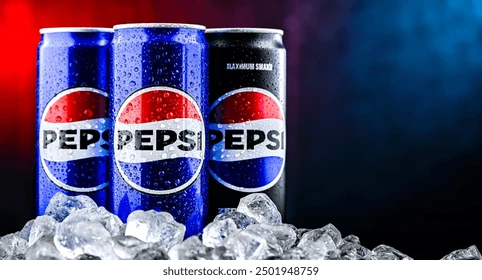Introduction
Pepsi is one of the most recognized and consumed soft drinks in the world. Owned by PepsiCo, this carbonated beverage has become a global symbol of refreshment, energy, and youth. Since its creation in the late 19th century, Pepsi has evolved from a simple cola drink to a vast product line including Pepsi Zero Sugar, Diet Pepsi, Pepsi Max, Pepsi Wild Cherry, and Pepsi Mango.
This article explores Pepsi’s history, production, ingredients, nutritional facts, business model, and a detailed calculation of its market performance and nutritional intake.
History of Pepsi
Pepsi was invented in 1893 by Caleb Bradham, a pharmacist from New Bern, North Carolina. Originally called “Brad’s Drink,” it was later renamed “Pepsi-Cola” in 1898. Bradham’s aim was to create a refreshing beverage that aided digestion and provided energy.
The name “Pepsi” is derived from the word “dyspepsia,” meaning indigestion. Over the decades, Pepsi underwent numerous transformations, competing head-to-head with Coca-Cola.
In the 1960s, the Pepsi Generation campaign revolutionized marketing, associating the brand with youth culture and vitality. Today, PepsiCo operates in over 200 countries, generating billions in annual revenue.
Ingredients of Pepsi
A standard Pepsi drink (355 ml can) contains:
- Carbonated water
- High fructose corn syrup (or sugar, depending on region)
- Caramel color (E150d)
- Phosphoric acid
- Caffeine
- Citric acid
- Natural flavors
Each ingredient plays a specific role in maintaining Pepsi’s signature taste and fizz. The caramel color gives it the deep brown hue, while phosphoric acid adds tanginess.
Nutritional Facts (Per 355ml Can)
| Nutrient | Amount | % Daily Value |
|---|---|---|
| Calories | 150 kcal | 7% |
| Total Fat | 0g | 0% |
| Sodium | 30mg | 1% |
| Total Carbohydrates | 41g | 14% |
| Sugars | 41g | — |
| Protein | 0g | 0% |
| Caffeine | 38mg | — |
Note: Excessive consumption of sugary sodas can lead to obesity, diabetes, and dental problems.
Calculation: Pepsi’s Nutritional and Business Impact
1. Sugar Intake Calculation
Each Pepsi can = 41g sugar.
If a person drinks 2 cans per day, monthly sugar intake =
41g × 2 × 30 = 2460 grams (2.46 kg of sugar)
That’s equivalent to nearly 490 teaspoons of sugar per month (1 teaspoon ≈ 5g).
2. Calorie Consumption
Each can = 150 calories.
2 cans per day = 300 calories.
Monthly total = 300 × 30 = 9,000 calories per month.
To burn 9,000 calories, an average adult would need about 12 hours of jogging.
3. Pepsi’s Market Revenue (Hypothetical Calculation)
If Pepsi sells 1 billion cans monthly at an average retail price of $1.50 per can, the gross revenue is:
1,000,000,000 × $1.50 = $1.5 billion/month
Annualized: $1.5B × 12 = $18 billion/year (approximation close to real-world PepsiCo beverage revenue).
Pepsi’s Global Reach
Pepsi is sold in more than 200 countries. Its top markets include the United States, India, Pakistan, Mexico, Russia, and the United Kingdom. PepsiCo also owns several other major brands like:
- Mountain Dew
- 7UP (in some regions)
- Gatorade
- Lay’s
- Doritos
- Tropicana
- Quaker Oats
This diversification helps PepsiCo maintain strong financial performance even when soda sales fluctuate.
Pepsi vs. Coca-Cola: The Rivalry
| Feature | Pepsi | Coca-Cola |
|---|---|---|
| Founded | 1898 | 1886 |
| Parent Company | PepsiCo | The Coca-Cola Company |
| Taste Profile | Sweeter, citrusy | Smoother, vanilla flavor |
| Market Share (Global) | ~42% (soft drink category) | ~46% |
| Flagship Campaign | Pepsi Generation | Share a Coke |
Pepsi often targets younger consumers with bold, energetic campaigns, while Coca-Cola focuses on tradition and togetherness.
Environmental and Health Initiatives
PepsiCo has taken steps to reduce its environmental footprint, such as:
- Using recyclable PET bottles
- Investing in sugar-free and zero-calorie beverages
- Committing to net-zero emissions by 2040
The company also promotes Zero Sugar as a healthier alternative for calorie-conscious consumers.
Popular Variants
- Diet – Introduced in 1964, zero calories.
- Max/Zero Sugar – Higher caffeine, no sugar.
- Wild Cherry – Cherry-flavored .
- Mango – Sweet tropical flavor twist.
- Nitro – Infused with nitrogen for a creamy texture.
Pop Culture
has collaborated with numerous celebrities such as Michael Jackson, Beyoncé, Britney Spears, and Cardi B. These partnerships enhanced Pepsi’s image as a trendy, youthful brand.
Pepsi’s Financial Overview (2024–2025)
- PepsiCo Revenue (2024): $91 billion (approx.)
- Beverage Segment Share: ~45%
- Marketing Expenditure: $4.2 billion annually
- Stock Performance: Stable growth of 6–8% year-over-year
These figures highlight PepsiCo’s strong market dominance despite increasing competition from energy drinks and healthy beverages.
FAQs
1. Who invented Pepsi?
Pepsi was invented by Caleb Bradham in 1893 in New Bern, North Carolina.
2. Is Pepsi vegan?
Yes, most Pepsi varieties are vegan-friendly, except for some special editions that may contain animal-derived ingredients (check the label).
3. How much caffeine does contain?
A 355ml can contains 38 mg of caffeine, less than coffee but similar to other cola drinks.
4. What’s the difference between Diet and Zero Sugar?
Both are sugar-free, but Zero Sugar has a bolder flavor and slightly more caffeine.
5. How many calories are in one can of ?
A regular 355ml can has 150 calories.
6. Which country consumes the most ?
The United States is Pepsi’s largest market, followed by India and Mexico.
7. What is the pH level of ?
Pepsi’s pH is around 2.5–2.8, making it quite acidic.
8. Is healthier than Coca-Cola?
Both have similar sugar and calorie levels; however, taste preference varies by individual.
9. When was PepsiCo founded?
PepsiCo was established in 1965 after the merger of Pepsi-Cola and Frito-Lay.
10. What is Pepsi’s slogan?
Recent slogan: “That’s What I Like.”
Conclusion
Pepsi’s journey from a small pharmacy drink to a global empire exemplifies innovation, marketing excellence, and adaptability. While it remains a favorite for millions, moderation is essential due to its sugar content. With healthier variants and sustainability goals, continues to evolve for the modern generation.

